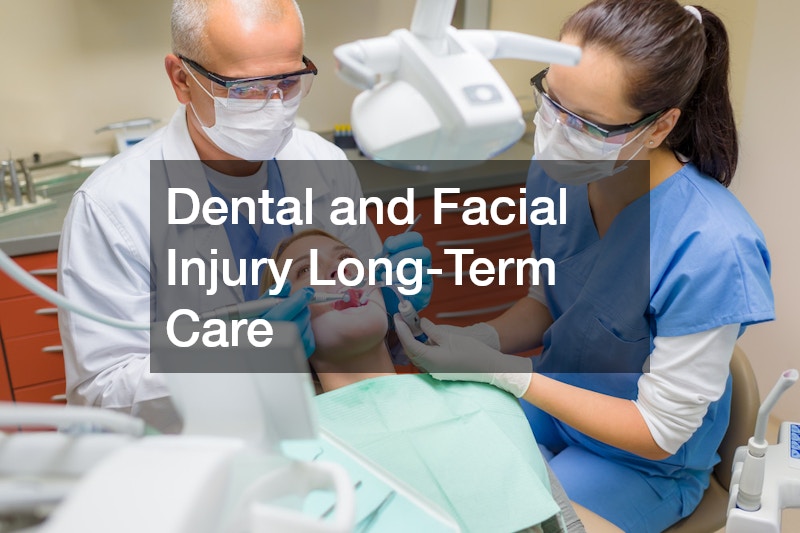Recovering from serious injuries can be a long and often complicated journey. While short-term treatment focuses on stabilization and immediate healing, long-term injury care requires ongoing adaptation, support, and planning. Individuals may face physical limitations, emotional challenges, lifestyle changes, and continuous medical appointments. Long-term recovery also depends heavily on personal resilience, access to coordinated healthcare, and supportive social networks. Over time, it can become less about “getting back to normal” and more about embracing new ways of living that prioritize well-being, safety, and independence. Throughout this guide, accident recovery will be discussed in depth, exploring how different strategies, resources, and care systems help people rebuild stability and confidence over months and years after the initial injury.
Understanding Long-Term Injury Challenges
Long-term injuries can vary widely in severity, cause, and impact. Some individuals deal with chronic pain, limited mobility, or nerve damage, while others experience cognitive, vision, or emotional effects that shape everyday life. Early in the process, the focus is typically on immediate stabilization, surgeries, or acute medical intervention. However, as time passes, many people must confront the reality that healing is not linear and that progress may come in small, gradual steps. This can create frustration, especially when improvements are slower than expected.
One of the biggest challenges is adjusting expectations. An injury that was initially described as temporary can sometimes develop into a long-lasting condition. This may affect work, relationships, recreational activities, and even daily routines. Some people may also feel a loss of identity if their physical abilities are tied to their sense of self, such as athletes, tradespeople, or individuals whose work depends heavily on physical labor. The psychological weight of this shift can be just as significant as the medical aspects.
Support systems play a crucial role during this time. Friends and family can help provide transportation, emotional comfort, and assistance with daily tasks, but professional care teams are equally essential. These teams can include physicians, therapists, counselors, and rehabilitation specialists who collaborate to create customized plans. Regular check-ins, goal-setting, and reassessment ensure that treatment remains aligned with progress.
Throughout these stages, accident recovery becomes an ongoing process of understanding one’s abilities, limitations, and evolving needs. Rather than focusing solely on what was lost, the journey encourages people to find new sources of strength, redefine independence, and develop sustainable long-term habits that promote healing and quality of life.
Coordinating Medical and Rehabilitation Care
Comprehensive healing requires collaboration among multiple care providers. For many individuals, long-term recovery begins with establishing a core medical team. This may include primary physicians, specialists, pain management professionals, mental health clinicians, and physical therapists. Recovery is rarely a single-step procedure—it evolves through consistent communication, coordinated scheduling, and detailed record-keeping.
In cases where movement, muscle function, or neurological response is affected, ongoing rehabilitation is central to maintaining and improving physical capability. Rehabilitation helps the body relearn, adapt, or strengthen functions impacted by injury. One valuable resource in these situations is local neuro rehab, which provides targeted therapy focused on restoring neurological and muscular function. Such programs often include occupational therapy, speech therapy, and physical retraining exercises tailored to each individual’s needs.
Collaboration also helps prevent conflicting treatments. For example, pain medication management must be coordinated carefully to ensure it does not interfere with physical therapy progress or mental well-being. Doctors may adjust dosages, try alternative therapies, or incorporate non-pharmaceutical pain relief techniques when appropriate. Rehabilitation specialists rely on feedback from both patients and physicians to determine the intensity and frequency of exercises, stretches, or movement training.
Family involvement can also support continuity of care. Loved ones can attend appointments, help track progress, and assist in communicating concerns that may arise between visits. Over time, structured support networks become essential in preventing setbacks and promoting long-term stability.
By viewing accident recovery as a process involving multiple layers of expertise, individuals can approach healing with realistic expectations and a strong foundation of guidance. Coordination ensures that medical care is not fragmented, but integrated, strategic, and responsive to both progress and challenges.
Pain Management Approaches and Adaptation
Pain is one of the most persistent challenges for individuals dealing with long-term injuries. Chronic pain can interfere with sleep, mood, attention, and mobility, making daily life significantly more difficult. Effective pain management often requires a multi-pronged approach that combines medical intervention, physical rehabilitation, mental health support, and sometimes alternative therapies.
Medication can be helpful, but long-term reliance may lead to complications. Overuse or dependency risks require careful monitoring and often necessitate ongoing dialogue with medical professionals regarding safer alternatives. Behavioral techniques such as mindfulness, breathwork, guided relaxation, and biofeedback can help some people manage discomfort more independently. Physical therapy and targeted exercise can gradually improve strength and reduce strain on affected areas, helping minimize pain flare-ups over time.
Another element that may arise during long-term healing is the emotional and psychological impact of pain. Chronic discomfort can lead to anxiety, depression, or feelings of isolation. It may also heighten stress responses, which in turn increase perceived pain levels. Individuals may need mental health support or counseling to process these challenges and develop coping methods.
For some, substance abuse therapy becomes an important component of the recovery journey. When pain medications or other substances become a coping mechanism rather than a structured part of medical treatment, professional support ensures safety and emotional well-being. Integrating this support into the broader recovery plan can help individuals regain control and stability in their daily lives.
By viewing accident recovery not just as a physical process, but as an interconnected experience involving both body and mind, people can foster healthier, more sustainable approaches to pain and adaptation. Pain may not disappear entirely, but with the right tools, its influence over daily life can be significantly reduced.
Emotional and Mental Health Support Over Time
Long-term injury recovery can be emotionally exhausting. People may experience grief over lost abilities, uncertainty about the future, or frustration with slow progress. Emotional fatigue is common, especially when improvements come in small increments rather than immediate changes. Support for mental well-being is as essential as medical treatment.
Therapy and counseling offer structured spaces to express fear, anger, sadness, or confusion. Mental health professionals can provide coping strategies, boundary-setting guidance, and stress-management techniques. They also help individuals navigate identity shifts, especially if the injury impacts work, hobbies, or independence.
Social support is also vital. Friends, family, support groups, and online communities can provide connection and affirmation. Sharing experiences with others in similar situations can reduce feelings of isolation. Peer perspectives can also offer practical suggestions and emotional encouragement that feel relatable and grounded.
Sometimes, emotional challenges manifest physically. Sleep disruptions, changes in appetite, or fatigue may signal the need for additional mental health care. Recognizing these patterns early helps prevent long-term distress. Self-compassion plays an important role here—progress is rarely linear, and setbacks are a natural part of healing.
Maintaining purpose and routine can also improve mental well-being. Activities that bring joy, stimulate creativity, or encourage learning can help individuals feel grounded and motivated. Even small, manageable tasks can restore a sense of achievement and control.
Throughout these emotional shifts, accident recovery continues to evolve, reflecting both internal and external growth. The ability to acknowledge challenges while still seeking progress is a defining component of long-term resilience.
Physical Mobility and Everyday Function Adjustments
Adjusting to changes in mobility can be one of the most visible long-term effects of injury. Whether an individual is relearning how to walk, adapting to balance challenges, or managing chronic joint pain, daily routines may need modification. Tools such as mobility aids, specialized footwear, and ergonomic home adjustments can significantly improve independence and comfort.
For individuals dealing with lingering foot, ankle, or mobility issues, working with a local podiatrist can provide specialized evaluation and treatment. Proper alignment and support can reduce pain, improve walking stability, and prevent secondary injuries caused by compensating movements. Customized orthotics, footwear recommendations, and physical mobility plans help individuals move more safely and efficiently.
Home modifications may also be necessary. These can include railings, ramps, widened doorways, shower seating, or rearranged furniture to ensure easy and accessible navigation. Adaptive tools such as reach extenders, grip-friendly utensils, and lightweight household items can also reduce physical strain.
Transportation and community participation sometimes require additional planning. Scheduling rides, planning accessible routes, or arranging assistance can allow individuals to maintain social engagement and independence. Structured exercise, such as gentle cardio, aquatic therapy, or walking programs, can also support long-term strength and wellness when guided safely.
Throughout these adjustments, accident recovery becomes a process of learning what works best, adapting the environment to meet physical needs, and finding new ways to stay active and confident in everyday life.

Dental and Facial Injury Long-Term Care
Injuries affecting the face, jaw, or teeth often require specialized and ongoing treatment. These injuries may result from vehicle collisions, sports accidents, workplace incidents, or falls. Depending on the severity, individuals may face challenges with chewing, speaking, or facial movement, and cosmetic concerns may also arise.
An oral surgeon often plays a central role in corrective procedures when bones, teeth, or jaw alignment are impacted. Surgical intervention may be necessary to repair fractures, reposition bone structures, or restore function. Following surgery, ongoing dental care helps maintain oral hygiene and prevent complications related to healing.
Some individuals may require a dental implant to replace lost or severely damaged teeth. This process can unfold over several months as the jawbone heals and adjusts. Once completed, the implant can restore bite strength, appearance, and comfort. Additional support may come through a restorative dentistry service, which can provide crowns, bridges, and cosmetic shaping to create a natural, balanced appearance and functional bite.
Facial trauma can also impact confidence and mental well-being. Frequent follow-up appointments, physical therapy for jaw or facial muscle function, and emotional support are essential components of long-term care.
Throughout these treatment phases, accident recovery emphasizes patience, consistency, and trust in skilled professionals who guide both function and aesthetic restoration. Healing may be gradual, but each step contributes to rebuilding confidence and comfort.
Vision, Skin, and Specialized Health Follow-Up
Some long-term injuries affect sensory systems or skin health. Vision changes, eye strain, or impaired focus may arise following head trauma or facial injury. Regular evaluations by local eye doctors help track vision changes, recommend corrective lenses, or provide therapy for visual processing challenges. Early intervention can significantly improve long-term outcomes and reduce daily frustration.
Skin damage—such as burns, scarring, or chronic irritation—can also require specialized care. Working with a dermatologist allows individuals to manage pain, irritation, and aesthetics. Treatments may include scar care procedures, topical medications, laser therapy, or protective skincare routines. Maintaining skin health is especially important when injuries affect mobility or create sensitivity that leads to further discomfort.
Monitoring these systems ensures ongoing stability and prevents complications that may develop months after the initial injury. Sensory health deeply influences quality of life—vision, skin comfort, and sensation contribute to emotional well-being, social confidence, and physical independence.
Throughout these follow-up stages, accident recovery remains a layered process that integrates medical expertise, self-awareness, and adaptable care strategies that evolve with time and healing.

Legal and Social Support Resources
Navigating the long-term effects of injury may also involve legal considerations. Medical bills, lost wages, insurance disputes, or liability questions can create stress that interferes with healing. In such situations, a personal injury accident lawyer can help individuals understand their rights, negotiate settlements, and advocate for fair compensation. Legal guidance ensures that financial burdens do not hinder access to proper care, rehabilitation, or long-term support tools.
Social services and community organizations can also provide valuable resources. Support groups, disability assistance programs, home care services, and transportation networks help individuals remain active and connected. These services reduce isolation and create opportunities for continued engagement in work, family activities, or hobbies.
Advocacy also plays a role. Individuals may need to communicate with employers, schools, or service providers to secure accommodations. Knowing how to request modifications respectfully and confidently ensures equitable participation in daily life.
Throughout these processes, accident recovery involves balancing physical healing with practical life management, ensuring stability across health, financial, and social dimensions.
Sustaining Progress and Long-Term Quality of Life
As months and years pass, recovery becomes a process of maintaining progress, preventing setbacks, and adjusting routines as the body and mind evolve. Long-term success relies on consistency: staying active within safe limits, attending follow-up appointments, seeking emotional support when needed, and maintaining healthy relationships. Personal goals may shift, and new interests or abilities may emerge along the way.
Finding meaning, joy, and confidence in everyday life is a central part of healing. Whether through creative expression, physical activity, learning, community engagement, or quiet routines, long-term well-being is built from many small, steady actions. Through these ongoing efforts, accident recovery continues to unfold—shaped not only by medical care, but by resilience, adaptability, and hope.


